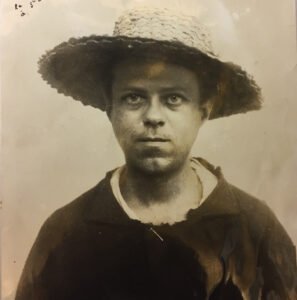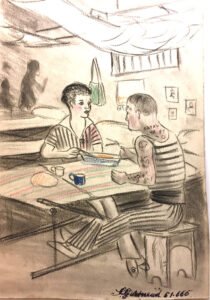A Pioneer in Gay and Prisoner Rights
Do you admire women who seize the chance to do what few other people have done? To count down the days to National Kick Butt Day, October 14, I am celebrating ten adventurous members of the Society of Woman Geographers (SWG). The tenth person to be honored is author and explorer Blair Niles.
Blair Niles on Devil’s Island, Harry Ransom Center
In 1926, a headline caught Blair Niles’ attention: Passengers for Eternity Board the Martinière—Broken Men Sail for Devil’s Island—Condemned to a Living Death. She put down the newspaper, dumbfounded. Although Blair had read many similar articles by journalists who had traveled to France to report on the embarkation of prisoners exiled to French Guiana, she realized that she had never read an article that told about what happened when the convicts arrived. She thought: “I long to know what lays behind the silence.”
Blair set to work getting permission to visit the South American penal colony. When she discovered that no foreigner had ever visited the prison on Devil’s Island, she feared that her plan was a mad impossibility. Undeterred, she asked the recently-appointed Governor of French Guiana, Gabriel Henri Joseph Thaly, for permission to visit. To her delight, the Governor gave her full access to the penal colony, including the three penitentiary islands.
She learned that under the French penal law of doublage, convicts sent to French Guiana had to serve sentences of up to eight years in prison and then serve an equal sentence in French Guiana. Doublage was Napoleon Bonaparte’s solution to the problem of populating French Guiana, which had been under French rule for over 200 years, and yet was still an isolated country. This was not as successful as Napoleon had hoped, as the women routinely had abortions. Eventually, the government halted the sentencing of female convicts to Guiana. In thirty years, no child had survived.
Blair arrived in French Guiana in time to witness the convict ship arriving from Marseilles, with 687 prisoners and 90 guards. As the prisoners spilled out of the ship after their twenty-day voyage, Blair thought they looked like gray rats, sweating in their thick woolen uniforms and blinking in the bright tropical sunshine. She thought:
They know little of the land where most of them have come to die.
She watched as they marched into the Camp de la Transportation, where they were registered into the prison system—stripped, processed, and assigned a number. The authorities inventoried “the men’s bodies, recording every distinguishing mark, every wart or mole, every birthmark blotch and every tattooed design, making measurements, and adding these things to his name and age and birthplace, and to the individual crime histories to facilitate emergency reference.” As she watched a man go through the registration process, she thought, “He is no longer a man; he scarcely has the individuality of a number.”
She suddenly realized that the officials were cataloging the prisoners. “It is as though the officials are amputating and preserving part of each man in card catalogs much like naturalists impale upon pins all that is mortal of once living insects, classifying them as Hymenoptera, Lepidoptera, and so on and so forth, the brittle remains of creatures who had known life. And standing naked in the room, man after man looks on with a sense of horror while an integral part of his ego is inventoried, impaled for all time in the criminal archives of Guiana, their human rights struggling there on a merciless pin

Île Royale Prison Cells
The inmates called the prison “The Dry Guillotine,” because “imprisonment in French Guiana was, to them, only a degree less fatal than the descending knife itself.” With dread, Blair predicted:
“Soon, each prisoner will understand that he has lost everything but the tortured physical body and his troubled spirit. And so faint, so uncertain will be his contact with the world that he will soon wonder which it is that has died—himself or the world.”
Wardens assigned most convicts to jungle work. Naked, the prisoners felled trees and hauled them away. Inmates assigned to road-building worked on grading a coastal road from the country’s borders: from Brazil to Dutch Guiana. The task was so abominable and deadly that a French journalist who visited Cayenne wrote:
“The question is whether this is a project to build a road or a project to kill convicts. If it’s a project to kill convicts, don’t change anything. All goes well.”
The road was abandoned at Mile 22, less than ten percent of its planned length.
Less fortunate inmates were assigned to Devil’s Island—Île du Diable, made famous when alleged traitor Alfred Dreyfus was incarcerated there. While she interviewed convicts, Blair lived in one of the guard’s houses on the Île Royale, the next island over.
A convict told her that more murders had taken place in the island’s prison bathrooms than in any place on earth.
Although Île Royale is a short distance from Île du Diable, it is separated by treacherous boulder-strewn and shark infested waters that make escape nearly impossible.
One of the prisoners who befriended Blair was René Belbenoît. He shared his prison stories with Blair many of the same tales he told other inmates such as Henri Charrière, who would later use them to write Papillion. During those meetings with Belbenoît, he told her about opportunistic homosexuality, true homosexual love, sexual abuse, and rape.

René Belbenôit, Harry Ransom Center
When she returned to New York, Blair wrote the fictionalized biography of René Belbenoît, who was imprisoned in France for theft and shipped off to French Guiana on the coast of South America to languish in the jungle prisons there. He had been in French Guiana for five years and had already tried to escape several times. Blair would give him money to plan his next unsuccessful attempt.
Condemned to Devil’s Island was an international bestseller. A reviewer praised her book, Condemned to Devil’s Island, as a “poignant study of the cruelty of justice in a dreadful tropic, and an exciting novel of accumulating movements, queer types, and exotic background. The system reeks with sodomy, grafts, sadism. Blair Niles has spoken adequately for the thousands who have perished on Devil’s Island.”
In 1929, Blair had spent a month in Hollywood, working as a consultant for Condemned!, a film based on her book. After a month in Hollywood, she quipped that she no longer needed any backs to her clothing because, in Hollywood, the backsides of everything are wood and chicken wire. The book and films helped bring public attention to the French Guiana prison system, and historians have credited Blair with pressuring the French government to close
Gay Harlem
When the Great Depression hit, Blair looked for subjects closer to home. She found inspiration for her next books when she attended a Harlem party hosted by A’Lelia Walker, a wealthy African-American patron of the arts. Walker had inherited her mother’s fortune from marketing her hair-straightening product—her mother was reputedly the first African-American millionaire and used it to throw lavish parties at her Hudson River mansion, and her Sugar Hill Harlem apartment. She enjoyed the company of artists, musicians, writers, and actors, especially gays. Carl Van Vechten also attended the gathering. He was “the undisputed downtown authority on uptown night life,” a frequent Harlem visitor, where he felt comfortable as a white gay man.
Through Van Vechten, Blair came to know Leland Pettit, a white gay church organist, who had moved from Milwaukee to New York to be closer to Harlem Renaissance poet Countee Cullen. They were reputed to be lovers. Historian Eric Garber concluded that “Pettit frequented the homosexual underworld in Harlem because he found social acceptance, and because he identified with others who were outcasts from American life. This identification and feeling of kindship, undoubtedly shared by other white lesbians and gay men, may have been the beginnings of homosexual ‘minority consciousness.’” In Blair’s next book, Strange Brother, she patterned the protagonist on Pettit, who identified with blacks in Harlem:
“I can be myself there. They know all about me and I don’t have to lie.”
When Countee Cullen married W.E.B. DuBois’s daughter, Yolanda, and moved to Paris, Pettit was devastated. He committed suicide at age 28.
Determined to write a fictionalized account of the anguish Pettit experienced before his death, Blair set out to find out as much as possible about homosexuality and Harlem. She learned that, although Black homosexuals faced discrimination, mockery, and arrest for their sexuality, Harlem carved out a place for gays and lesbians, and showed more tolerance than other parts of the country.
Although Black homosexuals faced discrimination, mockery, and arrest for their sexuality, Harlem carved out a place for gays and lesbians, and showed more tolerance than other parts of the country.
The book, Strange Brother, was the first book to depict gays in Harlem compassionately and discuss gay profiling. It received mixed reviews, although comments were mostly favorable. The New York Times refused to review it. The Saturday Review of Books commented that “a panorama of abnormality is unrolled with the utmost tolerance and sympathy, though never with approval.” The Cincinnati Enquirer said:
“Blair Niles is a woman. She has chosen for the theme of her book an “unwomanly” subject—and she has handled it well. Blair Niles has entered a dark and mysterious cavern and we may go with her.”
The Newark Advocate of Ohio wrote: “It is a delicate theme, handled with skill and perfect taste.” It cautioned: “Probably this book will titillate the suburban bridge clubs. That is unfortunate. It is no cheap shocker. It was written for the civilized adult.” But another reviewer noted that, like Condemned to Devil’s Island, Blair “is not so much telling a story as she is exposing suffering.”

Blair had satisfied her desire to explore the shadowy underworld of Harlem. Now that the economy was recovering from the Depression, she was ready to return to Latin America, a place where she always felt that she belonged.
In 1944, the Society of Woman Geographers awarded its third medal to Blair for her research and travels in Latin America. The Society’s president, Mary A. Nourse, noted that Ecuador regarded Blair’s book, Casual Wanderings in Ecuador, as the best book in English on the country. The City of Lima had awarded Blair a gold medal for her book, Peruvian Pageant, and the Department of Navy ordered 1,600 copies of Passengers to Mexico for their fleet libraries.
Despite Blair’s extraordinary accomplishments and her desire to curb prejudice of all kinds, history has almost completely ignored her. Yet, she is a role model for today’s women: a strong woman explorer and a courageous writer who helped millions of readers understand the injustices faced by homosexuals, prisoners, black slaves, and women, during a time of rampant racism and discrimination.




-Comments-